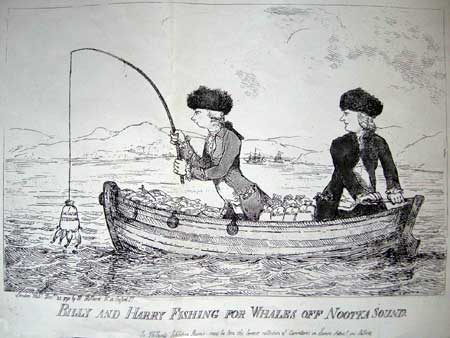
BILLY AND HARRY FISHING FOR WHALES OFF NOOTKA SOUND
[H. Woodward ?] London pubd: Dec: 23, 1790 by W. Holland No. 50. Oxford St:
In Hollands exhibition rooms may be seen the largest collection of caricatures in Europe. Admit one shilling.
VERY RARE. Excellent condition, small margins,
9 7/16 x 13 1/4” (23.9 x 33.5 cm.) Ref. LRAp1248/AEV/e.dnon >ARVL SOLD
Description: A very rare original hand coloured copper etching on laid paper depicting a small wooden ship’s boat (foreground facing L.) in which two gentlemen are seated. (At R.) Henry Dundas is caricatured wearing a waistcoat, jacket and (sea otter fur hat, with both hands on the tiller of the boat. His jacket pocket is stuffed to overflowing with small fish. (profile L.) He looks at his partner, William Pitt, caricatured as facing the prow (L.) of the boat over which he is fishing with a pole and line, held between both his hands. He is similarly attired in breeches, waistcoat and jacket with shirt ruffles; atop his beribboned wig sits a distinctive fur hat. From his jacket pockets also protrude small fish.
Attached to the end of the line as bait, is a bag inscribed ‘1 million sterling’ to which in turn are attached his catch of four dolphin like fish representing Whales. The front third of the boat is full of previously caught sea creatures (Whales). Between the two men are stacked seven more bait bags, four which are also inscribed ‘1 Million’.
In the center background are seen two British sailing ships, (probably those of Meares) beyond which lie a line of hills at the opening to a Sound (Nootka). Some rude huts (Meares’ trading establishment) may just be discerned at the base of a cliff (Center L. between Pitt’s hands). The whole scene is set upon a calm sea, beneath a slightly clouded blue sky.
Explanation: In 1789 Spain seized a British trading station, fishing and fur trading vessels belonging to John Mears at Nootka Sound (Vancouver Island) which was then claimed by both Spain and Britain, sparking off the Nootka Controversy. On 21 January 1790 the first news of the Spanish attack reached London. In reply to the British demand for satisfaction the Spanish claimed exclusive sovereignty over the Pacific coast of North America.
In April and May as positions hardened, both countries were arming for a conflict. Debated in Parliament, a £3,000,000 line-of-credit was approved as proposed war expenses. However, a peaceful solution to the crisis was negotiated by Capt. George Vancouver & Don Juan Francisco de la Bodega y Quadra which resulted in the Nootka Convention.
Reparations and the release of Meares’ ships resulted. The convention with Spain which settled the controversy on terms favorable to Briton (thus laying the foundations of British Columbia) stated, that in order to prevent illicit trade with established Spanish settlements it was agreed that the British traders and fisherman would not fish within a 10 league limit of the Spanish occupied Pacific Coast, but temporary dwellings for fish, whale and fur processing were permitted.



